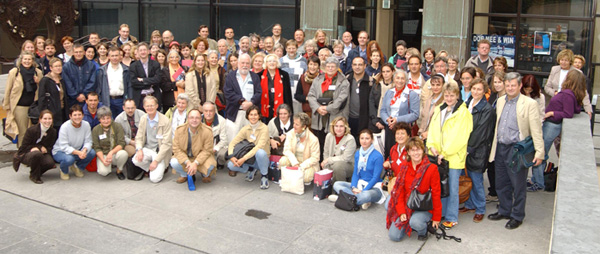H I S T O R I A F A V T O R V M
A (partly personal) illustrated history of the RCRF
Susanne Zabehlicky-Scheffenegger
|
This outline of the history of the RCRF was first compiled for a lecture on occasion of the foundation of the Iberian pottery association SECAH at Cádiz in 2011 (S. Zabehlicky-Scheffenegger, RCRF – Fifty-five years of Roman pottery studies. In: D. Bernal/L.C. Juan/M. Bustamante/J.J. Díaz/A.M. Sáez (eds.), Hornos, talleres y focos de producción alfarera en Hispania. I congreso internacional de la SECAH ex officina hispana, Cádiz 3–4 de marzo de 2011. Monografías Ex officina Hispana 1, tomo 1 [Cádiz 2013] 115–137) and could be repeated on occasion of the 28th congress of the RCRF in 2012. Here is a slightly modified version, especially illustrated by more pictures. It would be a great help if one or the other could help us to identify the persons pictured but not yet labelled! |
The RCRF, an abbreviation for „Rei cretariae Romanae fautores“,
which means the people who care about Roman pottery,
„is an international learned society specialising in the field of Roman pottery.
Its main aim is to establish contact between scholars of different countries
and the field of interest
is interpreted in its widest sense“.
So far the „official“ definition as provided by Philip Kenrick.
|
| |
 1 Howard Comfort (1904-1993) 1 Howard Comfort (1904-1993)
 2 H. Comfort, De collectione praecipue epigraphica vasculorum Arretinorum apud Academiam Americanam conservata. Memoirs of the American Academy in Rome 7, 1929, 177-219 2 H. Comfort, De collectione praecipue epigraphica vasculorum Arretinorum apud Academiam Americanam conservata. Memoirs of the American Academy in Rome 7, 1929, 177-219
 3 A. Oxé/H. Comfort, Corpus Vasorum Arretinorum (Bonn 1968) 3 A. Oxé/H. Comfort, Corpus Vasorum Arretinorum (Bonn 1968)
|
The Society was founded in 1957 by the late Professor Howard Comfort [1], professor of Classics at Haverford College, Pennsylvania.
Born in 1904 into a Quaker family at Haverford, he also studied there and took his Ph.D. at Princeton in 1932. He then returned to Haverford where he taught until his retirement in 1969.
A fellowship at the American Academy in Rome in the late 20s of the last century brought him into contact with Roman pottery and especially Italian sigillata stamps [2], to which in consequence he devoted most of his scholarly work, crowned by his edition of the standard catalogue of potters’ stamps on Italian sigillata published in 1968 [3].
After the successful foundation of the society of the Fautores he served as its President for many years and was always unquestionably its guiding spirit. His presence at the congresses fired everyone with enthusiasm and he set an abiding example of interest and academic generosity toward the younger generation. He was always ready to listen to new ideas and to share the benefits of his experience and knowledge.
A bottle of gin was always with him and I remember many late evenings with a lot of “orange blossoms”. Another important part of his life was the sport of cricket!
He died in 1993.
During and after World War II he maintained an extended correspondence with other sigillata specialists and from this grew a wish to know more about these individuals personally. His idea that the progress of the subject would benefit directly from bringing together specialists who often worked in isolation found a ready response among those to whom he proposed a meeting to discuss Roman pottery studies. |
His letter from December 31, 1956 [4] reads:
Dear Friends:
After considerable correspondence, especially with Elisabeth Ettlinger, and conversation with others on her part and mine, I am writing to 35 or 40 specialists in Roman imperial ceramics proposing that those of us who are principally active in this field meet at some convenient place for three of four days preceding the Archaeological Congress at Pavia in September 1957 (a) in order to make each other’s better acquaintance, (b) to discuss a variety of mutually interesting matters, including the formation of a permanent organization if that seems desirable, (c) to exchange informal “shop talk”.
Would you drop me a line indicating (1) whether you are interested and would be likely to join us; (2) who else you think should be included in such a meeting of “narrow specialists”, with their addresses; (3) where you would like to meet, with or without an invitation from a museum, learned society, or other auspices; (4) what general or specific thoughts you think we should bring to the occasion? If your answer to (1) is affirmative, I shall keep you informed of further developments; if you reply to (2), I shall be glad to send a copy of this letter to your nominee.
This much seems clear: that there is some interest in meeting and in organizing ourselves in at least some loose permanent form, with the birth of a new periodical as a possible result. Such being the case, it seems wise not to plan at this point the formal presentation of the usual type of papers at the first meeting. It also seems wise not to think in terms of inviting to this meeting a number of more widely generalized Roman archaeologists who are non-specialists in the ceramic field.
Sincerely,
Howard Comfort.
In a later letter in March 1957 [5] to 35 persons who responded positively to his first letter, Comfort announced that the first meeting would take place at Brugg by invitation of the director of the Vindonissa-Museum, Rudolf Fellmann, on September 2-4, 1957.
Some quotations:
The chief interest expressed in our meeting seems to be the personal satisfaction of coming to know colleagues vis-à-vis, closely followed by a sense of need for some permanent organization with a scholarly program. Commissions on a standard system of reference for vase-shapes, on the compilation of a consolidated text-book on Roman imperial ceramics, on publications ranging from newsletters to a scholarly periodical, and on other matters, have been suggested. …
Allow me to express … my own personal anticipation of the pleasure of meeting at Brugg with as many of you as may find it possible to attend. It should be a significant occasion – perhaps even historic.
Cordially,
Howard Comfort
|
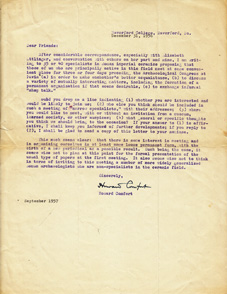
4 Letter by H. Comfort, 31. 12. 1956.
For better quality see here
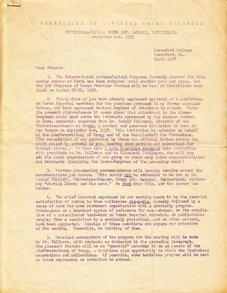
5 Letter by H. Comfort, March 1957
|
 6 Elisabeth Ettlinger (1915-2012) 6 Elisabeth Ettlinger (1915-2012)
 8 Ettlinger and Comfort, Vichy 1968 8 Ettlinger and Comfort, Vichy 1968
 9 Comfort and Ettlinger, 9 Comfort and Ettlinger,
Magdalensberg 1972
 10 Comfort and Ettlinger, Le Rozier 1980 10 Comfort and Ettlinger, Le Rozier 1980 |
The by far greatest part of his correspondence in planning and preparing the first reunion Comfort exchanged with Elisabeth Ettlinger [6], who immediately shared with him the enthusiasm and readiness for action in order to convert the mere idea into a fact.
She was born in 1915 at Breslau. There and in Berlin she grew up, before the family had to leave Germany for Switzerland, where Elisabeth studied archaeology, ancient history and history of art at Basel.
Already her PhD thesis “Die Keramik der Augster Thermen” – the pottery found in the thermae at Augst –, published in 1949 [7], emphasized her main interest, the pottery of the Roman provinces. But besides that she also became a specialist of fibulae. After a visiting fellowship at the Institute of Advanced Studies at Princeton she taught Roman provincial archaeology at the University of Bern, where she also obtained a professorship in 1970.
She set standards and advised generations of students – not only Swiss ones – being generously helpful with her knowledge and advices and offering an open house for many scholars and students at Zürich. I gratefully remember many wonderful and fruitful visits there, which always included interesting conversations with her as well as with her husband Leopold.
In the first nine years, from 1957 to 1966, she served as Secretary of the Fautores, then became Vice-President and later on was President from 1971 to 1980. She died in 2012.
Howard Comfort and Elisabeth Ettlinger, the tall man and the tiny woman, both always active and interested in everything, became the real “parents” of the Fautores and never ceased to be the guiding spirits of the society, the “Vereinli”, as it was called with its Swiss-born nickname [8-12].
When we celebrated Elisabeth’s 70th birthday in 1985 [13] – and she in the late evening already had left the party – we still sat together with Howard until long after midnight; having been asked whether he didn’t want a rest too, he only replied “I didn’t come all the way over the ocean to sleep”!! He was 81 at that time... |
 7 E. Ettlinger, Die Keramik der Augster Thermen (Basel 1949) 7 E. Ettlinger, Die Keramik der Augster Thermen (Basel 1949)
 11 Comfort and Ettlinger, Pavia 1990 11 Comfort and Ettlinger, Pavia 1990
 12 Comfort and Ettlinger, Pavia 1990 12 Comfort and Ettlinger, Pavia 1990

13 Elisabeth Ettlinger, Vindonissa 1985 |
___________________________________________________________________________________ ___________________________________________________________________________________
The Congresses
1957 1958 1961 1963 1965 1967 1968 (inf. meeting) 1969 1971 1972 (inf.meeting) 1973 1975 1977 1980
1982 1984 1986 1988 1990 1992 1994 1996 1998 2000 2002 2004 2006 2008 2010 2012 2014
___________________________________________________________________________________
1st congress: Baden - Brugg (CH), 1.-2. 9. 1957
When finally the first meeting was set up by a lot of correspondence, on August 31 Elisabeth Ettlinger and Howard Comfort were sitting the whole day long in the waiting room of the tiny railway station at Baden expecting any arrival. For a long time and many trains arriving nothing happened. But suddenly Donald Atkinson opened the door and afterwards by and by all the others came in, except Éva Bónis, who couldn't get a visa (after Ettlinger's memoirs in the Communicationes 39, 1997, 65-66, see [146]). Surely these were long hours full of expectation! The following day saw various reports and discussions, including some pottery pieces from Sabratha brought by Kathleen Kenyon. All were so absorbed by these topics that they didn't even notice that the mayor of Baden entered to offer an aperitif (ibid.)! And eventually the "business matters" were discussed on the last day.
Unfortunately of the first meeting there is only one single picture left [14], and that shows a nice ladies’ coffee-party with a couple of founder-Fautores and the wives of other male ones as Ohlenroth and Palol.
|
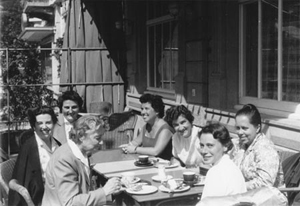
14 1957 Carolina Martínez, Irma Čremošnik, Mrs Ohlenroth, Mrs Palol, Frances Jones, Elisabeth Ettlinger, Auguste Bruckner |
The founders who gathered at the railway restaurant at Baden and in the museum of Vindonissa from 31 August to 3 September were:
From Austria: Paul Karnitsch and Hedwig Kenner
From Belgium: Joseph Mertens
From France: Jaques Gourvest, Jean-Jacques Hatt, Marcel Lutz, Yves Rigoir
From Germany: Berndmark Heukemes, Hans Klumbach, Rolf Nierhaus, Ludwig Ohlenroth, Harald v. Petrikovits, Wilhelm Schleiermacher and Hans Schönberger
From Great Britain: Donald Atkinson, Eric Birley, John Gillam, Kathleen Kenyon
From Italy: Nino Lamboglia
From the Netherlands: Julianus E. Bogaers, Hendrik Brunsting, C.G.A. Morren
From Spain: Alberto Balil, Carolina Martinez, Pedro de Palol
From Switzerland: Auguste Bruckner, Rudolf Degen, Elisabeth Ettlinger, Rudolf Fellmann
From USA: Howard Comfort, Frances Follin Jones
From Yugoslavia: Irma Čremošnik
The main aim of this meeting was of course extensive personal contact and to consider the future of a scholarly association with various committees, members, scholarly projects, publications and so on.
The first Statutes were already established [15], and you may notice that the original name of the association was longer, adding “ubique consistentes” – wherever they are, but being too complicated this addition was soon abandoned.
A Council was formed by a President (Howard Comfort), Secretary (Elisabeth Ettlinger) and Treasurer (Philippe de Schaetzen) leading a permanent committee of ten people, the “decemviri”. This construction did not last for long, but it is not clear when it ended - surely after 1964 (see Statutes 1964).
Further, one person per country reported about the state of the art and special problems in their respective countries. They should also act as “national secretaries”, as pointed out by Elisabeth Ettlinger in letters sent out immediately after the meeting [16-17], together with the Statutes. These national secretaries should contact their fellow nationals, collect offprints, future articles and bibliographical notes. How long that hierarchy worked, I also do not know. |
 15 Statutes 1957. For better quality see here 15 Statutes 1957. For better quality see here
 16 Communication by E. Ettlinger, September 1957.
For better quality see here 16 Communication by E. Ettlinger, September 1957.
For better quality see here
 17 Letter by E. Ettlinger, September 1957. For better quality see here 17 Letter by E. Ettlinger, September 1957. For better quality see here
|
__________________________________________________________________________________________
2nd congress: Arezzo (I), 4.-5. 9. 1958

18 1958 Alberto Balil, Howard Comfort, Ludwig Ohlenroth, Hans Klumbach, Paul Karnitsch |

19 1958 Alberto Balil, Arturo Stenico, ?, Howard Comfort |

20 1958 Auguste Bruckner, Hans Klumbach, Elisabeth Ettlinger, Alberto Balil |

21 1958 ?, Helen Russel-White, Dorothy Charlesworth, John Gillam |

22 1958 Alberto Balil, Howard Comfort |

23 1958 Howard Comfort, Ludwig Ohlenroth, Hans Klumbach, Kathleen Kenyon
|
| |
Already the next year saw the second congress at Arezzo, the most famous and central place for Italian sigillata (and Comfort's first choice for the founding gathering) [18-32].
Well known up to now, at least from the literature, are, besides Comfort and Ettlinger, Alberto Balil and Pedro de Palol from Spain, Nino Lamboglia and Arturo Stenico from Italy, Hans Klumbach and Ludwig Ohlenroth from Germany, Kathleen Kenyon and John Gillam from Great Britain.
Presumably less known to everybody is the Austrian Paul Karnitsch, a self-taught sigillata specialist. But it was him who, on occasion of the first meeting in the railway restaurant, suddenly took a paper napkin from the table and drew the RCRF icon in the planta pedis! So it is he to whom we owe our “identity”.
There were discussions and lectures as well as excursions and toasts at dinners – so the whole range we so like at congresses up to now.
Excursions led to Florence and later on to Pompei and Naples and everywhere there were the showcases and boxes open and photographing allowed. It was agreed upon that meetings thereafter should take place only every two or three years. |
|
| |
|
| |
|
|

27 1958 John Gillam, Elisabeth Ettlinger

30 1958 Arturo Stenico

31 1958 Pedro de Palol
|

24 1958 Paul Karnitsch, Nino Lamboglia, ?, Dorothy Charlesworth, Elisabeth Ettlinger, ?, John Gillam
|

25 1958 John Gillam, Howard Comfort |

26 1958 Ludwig Ohlenroth, Hans Klumbach |

28 1958 Elisabeth Ettlinger, Wilhelm Schleiermacher,
John Gillam
|

29 1958 Kathleen Kenyon, Helen Russel-White, John Gillam, Dorothy Charlesworth |

32 1958 Mario Salmi, Elisabeth Ettlinger, Howard Comfort, ?, ? |
__________________________________________________________________________________________
3rd congress: Klagenfurt (A), 6.-9. 9. 1961

34 1961 Pottery exposition.
For the names see here

35 1961 Pottery exposition.
For the names see here |
|
 33 1961 Maria Schindler preparing the pottery exhibition
33 1961 Maria Schindler preparing the pottery exhibition
1961 the Fautores gathered at Klagenfurt, Austria, and visited “my” excavation, the Magdalensberg.
Pottery was exposed there in two Roman cellars [33-37]. The young men John Hayes and Günter Ulbert for the first time joined a RCRF-Congress.
|
|

36 1961 Pottery exposition.
For the names see here

37 1961 Marcel Lutz, Hugues Vertet |
After the congress Ettlinger reported to Comfort, who could not come, and commented on the lectures (all but one concerning sigillata items) of Gillam, Kenner, Klumbach, Lutz, Vauthey (read by Lutz), Vertet, Stenico, Thomas, Ettlinger and Comfort (read by Gillam), and later on recollected her great delight in the landscape and the order of the sherds. |
__________________________________________________________________________________________
4th congress: Strasbourg (F), 14.-17. 9. 1963

39 1961 Howard Comfort, Jean-Jaques Hatt
 40 1963 Elisabeth Ettlinger, Éva Bónis 40 1963 Elisabeth Ettlinger, Éva Bónis

41 1963 John Gillam, Grace Simpson

42 1963 Ingeborg Huld, Howard Comfort

44 1963 John Gillam |

38 1963 Fautores at Boucheporn. For the names see here
|

43 1963 Elisabeth Ettlinger, ?, Jean-Jaques Hatt

45 1963 Berndmark Heukemes, Elisabeth Ettlinger, Mlle Sauer, Wolfgang Hübener, ?, Ingeborg Huld, Hugues Vertet

46 1963 At Boucheporn.
For the names see here
 47 1963 Ingeborg Huld, Wolfgang Hübener, Mlle Sauer 47 1963 Ingeborg Huld, Wolfgang Hübener, Mlle Sauer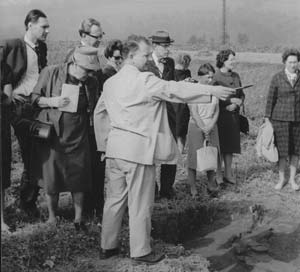 48 1963 At Boucheporn.
For the names see here 48 1963 At Boucheporn.
For the names see here 49 1963 For the names see here 49 1963 For the names see here
 52 Statutes 1964. For better quality see here 52 Statutes 1964. For better quality see here |
After Switzerland, Italy and Austria the next country to host the Fautores was France.
26 Fautores gathered at Strasbourg and communicated 13 lectures.
While the lectures were held at the Château Rohan surrounded by the archaeological collection, a tour on the last day led through the Lorraine, visiting the excavations at St-Ulrich and Boucheporn as well as the museums at St-Avold and Sarrebourg [38-51].
Elisabeth Ettlinger told the funny story that she and Comfort circled the city twice in a tram, just to have a quiet hour to speak to each other.
The Statutes were amended insofar as the Editor of the Acta - for a long time it was Michel Vanderhoeven - now became a member of the Council too and elections were scheduled every six years (with the possibility of a re-election) [52].
And there was a change in the Council: Auguste Bruckner became Treasurer instead of Philippe de Schaetzen. Comfort and Ettlinger were approved again as President and Secretary.
There were already 118 individual and 40 affiliated members listed.
|
 50 1963 For the names
see here 50 1963 For the names
see here
|
 |
51 1963 Klára Póczy, ? |
_________________________________________________________________________________
5th congress: Alcudia (E), 24.-30. 8. 1965
1965 the Fautores went to Spain. That was a rather small congress with only 15 participants (7 countries) and 8 lectures, 7 of them dealing with various sigillatas. The Fautores were hosted in the Renaissance palace of the Bryant-Foundation and private rooms, as there was no hotel there at that time.
There were excursions round Mallorca [53] guided by Antonio Arribas and to Barcelona, Ampurias and Gerona guided by Pedro de Palol. Midday bathing contributed much to the pleasant atmosphere, as reported in the Communicationes.
The annual subscription was raised by 50% to sfr. 15.
Elisabeth Ettlinger was replaced by Hans-Jörg Kellner as Secretary.
The overall resources of the RCRF amounted to $ 880. |

53 1965 Fautores at Mallorca. For the names see here
|
_________________________________________________________________________________
6th congress: Budapest (H), 4.-8. 10. 1967
 55 1967 Ferenc Fülep, Howard Comfort 55 1967 Ferenc Fülep, Howard Comfort

56 1967 For the names see here

57 1967 For the names see here
 59 1967 Fautores overlooking Budapest 59 1967 Fautores overlooking Budapest
|
 54 1967 Invitation
54 1967 Invitation |
|
At Budapest 40 Fautores from 12 countries were welcomed by Ferenc Fülep and Éva Bónis as well as the local sigillata potter Pacatus and his colleagues [54].
The lectures at Budapest took place in the National Museum amongst many stuffed animals, including the wise owl [55]. 18 international participants from ten countries (including a lot of seven from Germany) faced 19 Hungarians [56-58].
In her speech about 10 years of RCRF Elisabeth Ettlinger glanced back at the circumstances of its foundation, quoting Comfort’s letter from 1956: “Certainly those of us interested in this field have a good deal in common with each other, but we have no regular channels for intercommunication” and then reported that the members at this point, 10 years later, reached 175 individuals and 51 institutions – so the personal contacts without any doubt have been much increased! She then listed about 30 important publications which show the huge progress in pottery research within these 10 years.
Two days of work with 20 lectures were followed by two days of excursions visiting various sites in Budapest itself [59] and going to Székesfehérvár, Tác/Gorsium [60-61], Veszprém and Tihany on the shore of lake Balaton.
The Council was enlarged by an Associate Secretary, Bogdan Rutkowski.
|
 58 1967 Howard Comfort, Ferenc Fülep 58 1967 Howard Comfort, Ferenc Fülep
60 1967 Éva Bónis, Michel Vanderhoeven, Maria Schindler, Renate Pirling, Howard Comfort at Gorsium 61 1967 Ruth Steiger, Waltraud v. Pfeffer at Gorsium 61 1967 Ruth Steiger, Waltraud v. Pfeffer at Gorsium |
__________________________________________________________________________________________
1st informal meeting: Moulins - Vichy - Lezoux (F), 6.-9. 9. 1968
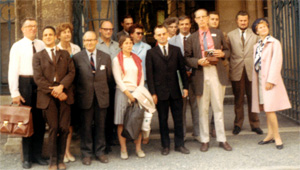
62 1968 Fautores at Moulins. For names see here
|
Besides the regular congresses there happened also informal "rencontres des amies", of which the first one took place in 1968 in France, invited by Hugues Vertet, and aimed mainly to see the recent finds of the Augustan-Tiberian productions at Lyon, La Muette and Lezoux.
Being an informal meeting without lectures, only the small number of 15 participants was invited [62-63].
A special highlight of this meeting was the fact, that at Moulins Howard Comfort received the first (not yet bound) volume of the "Oxé-Comfort" corpus of Italian sigillata stamps.
|
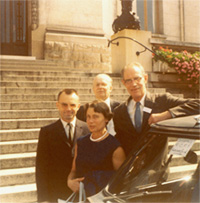
63 1968 Hugues Vertet, Elisabeth Ettlinger, Max Vauthey, Howard Comfort at Vichy |
__________________________________________________________________________________________
7th congress: Speyer (D), 17.-20. 9. 1969
The meeting at Speyer, organized by Otto Roller, already started with an evening for discussions on the day of arrival, followed by two days with 15 lectures and an excursion to Rheinzabern, Heidelsburg, Schwarzenacker und Blickweiler, the first and last famous sigillata production centres of the region.
It marked the first time after the war that the huge collection of Rheinzabern was open to the public again.
Kalman Reti sent a paper entitled "Computer-aided identification of fragmentary potters' stamps", which was very much discussed - in 1969!!
Two longer newspaper articles are stored in our archive with a picture of the Council Members [64-66]. Let me quote one of them: “Pottery is more important for them than politics” is the caption of the article and it continues “We are a big family and are steadily in contact by letters. … People from 11 countries gathered at one of their biennial meetings, of which the last one took place at Budapest. As the President Howard Comfort pointed out: ‘In this respect there doesn’t exist an Iron Courtain and no separations as caused by politics’ ”.
At that point the RCRF had already 270 members. |
 64 1969 Hans-Jörg Kellner, Michel Vanderhoeven, Elisabeth Ettlinger, Howard Comfort 64 1969 Hans-Jörg Kellner, Michel Vanderhoeven, Elisabeth Ettlinger, Howard Comfort |

65 Speyerer Rundschau, 22.9. 1969. For better quality see here |

66 Pfälzer Heimat 20, 1969. For better quality see here |
__________________________________________________________________________________________
8th congress: Nijmegen (NL), 14.-18. 9. 1971
 67 1971 Newspaper, 16.9.1971. 67 1971 Newspaper, 16.9.1971.
For better quality see here |
The gathering of 65 participants from 13 countries in the Netherlands, organized by A.V.M. Hubrecht, again was reflected in the local newspapers [67].
The lectures held on two days once again concentrated mainly on sigillata items. From an informal script of the discussion I learnt what a hypothetical status the research had at that time, but on the other hand main questions concerning productions and their proof by chemical analyses (by Maurice Picon) started already then.
|

69 1971 Michel Vanderhoeven, Howard Comfort, Hans-Jörg Kellner, Elisabeth Ettlinger |
|
Lovely to read that after lectures on 3rd century sigillata from Trier (and obviously some pottery display) Comfort found his misgivings confirmed, that the “actuality was just as bad and ugly as the drawings” had suggested; he considered the degeneration of artistic craftmanship and trend of evolution between the Augustan arretine and the 3rd century provincial productions. These long and fruitful discussions seriously interfered with the scheduled time-table.
Excursions went to Elst, Utrecht, Leiden as well as to Tongeren (in Belgium), Maastricht and Heerlen. At Tongeren a group photo was taken [68] and when we visited Tongeren again in 2004, we deliberately took a group photo there again [see 170]. The Council [69] changed insofar, as Comfort resigned as president with the words “it is time for a change!” and was followed by the former Vicepresident Elisabeth Ettlinger, while Arend Hubrecht became Secretary. Howard Comfort was appointed Honorary President.
| |

68 1971 Fautores at Tongeren. For the names see here |
|
|
__________________________________________________________________________________________
2nd informal meeting: Magdalensberg (A), 25.-26. 8. 1972

70 1972 Programme |
The second of the informal meetings with only a few participants took place at the Magdalensberg in 1972 for two days [70]. And that was the occasion when Eleni Schindler Kaudelka and I as students first came into contact with the Fautores, mainly with Comfort and Ettlinger [71]. And it was Comfort with whom I sat together for many hours and we went through my files of the Italian sigillata stamps from the Magdalensberg (which later on became my PhD thesis). There I experienced not only his enormous knowlegde, but especially his lovely generosity to share it with young people for hours and hours. |
 71 1972 Howard Comfort, Elisabeth Ettlinger, Eleni Kaudelka, Susanne Scheffenegger 71 1972 Howard Comfort, Elisabeth Ettlinger, Eleni Kaudelka, Susanne Scheffenegger |
__________________________________________________________________________________________
9th congress: Ljubljana (SI, that time YU), 5.-8. 9. 1973
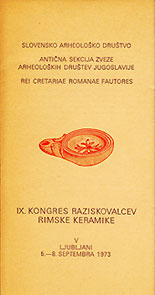
72 1973 Programme |
In 1973 61 participants from 12 countries met at Ljubljana [72].
It was organized by Ljudmila Plesničar-Gec, Iva Mikl-Curk and Peter Petru.
This was my first formal congress and since then with only one exception I attended all of them.
The first day was devoted to lectures concerning finds from Yugoslavia and mainly Slovenia and a guided tour to the Roman remains of Emona, while the second day was filled by other subjects and a pottery exposition. And on the third day we made an excursion to Celje, Šempeter and Ptuj [73]. |

73 1973 Fautores at Ptuj. For the names see here |
__________________________________________________________________________________________
10th congress: Augst - Kaiseraugst (CH), 4.-9. 9. 1975

74 1975 Teodora Tomasevic at Lenzburg

75 1975 Programme |
The meeting at Augst, organized by Teodora Tomasevic [74], marked the jubilee of the 10th RCRF congress and was held again in Switzerland [75]. 94 participants from 17 countries were present.
It also praised the 60th birthday of the then President Elisabeth Ettlinger [76] and in celebration she was given a box with a collection of her smaller articles, published in various and partly not very accessible places, ready to be published (in 1977) as the second volume of the RCRF Acta Supplementa [77].
The first part of the 38 lectures was arranged geographically from west to east, from "Roman and native pottery in Britain" (K. Greene) to "The pottery of the Nabatean necropolis at Mampsis" (A. Negev). Then followed general subjects, methodology, synopses and kiln sites.
|
 76 1975 Elisabeth Ettlinger, Klára Póczy 76 1975 Elisabeth Ettlinger, Klára Póczy
 77 Kleine Schriften, RCRF Supplementa 2 77 Kleine Schriften, RCRF Supplementa 2 |
|
|

78 1975 Fautores at Augst. For the names see here
 79 1975 Fautores at Augst. 79 1975 Fautores at Augst.
For the names see here
 80 1975 Fautores at Augst. For the names see here 80 1975 Fautores at Augst. For the names see here |
There were visits to Augst [78-81] and two full-day excursions to Lenzburg [82], Buchs, Seeb and Zurzach as well as to Avenches [83-85] and a chance to choose between visits of the museums at either Basel or Brugg and Zurich on the last day.
Changes in the Council were as follows: the Secretary Arend Hubrecht as well as the Treasurer Auguste Bruckner stepped down and were replaced by Teodora Tomasevic and Simon Wynia, respectively.
|

83 1975 Fautores at Avenches. For the names see here

84 1975 Susanne Scheffenegger, Eleni Schindler Kaudelka, ?, Jan Kees Haalebos, Avraham Negev, B.L. van Beek at Avenches

85 1975 Colette Bémont, Hendrik Brunsting, Maria Schindler, Hans Klumbach, Eleni Schindler Kaudelka at Avenches |

81 1975 M.D. de Weerd, Simon Wynia, Maria Schindler, Sophie van Lith, Michel Vanderhoeven, Jan Kees Haalebos at Augst |

82 1975 Sophie van Lith, Joseph Mertens, Jan Kees Haalebos, Mrs Brunsting, Éva Bónis, Hendrik Brunsting, ? at Lenzburg |
|
|
|
|
|
|
__________________________________________________________________________________________
11th congress: Metz - Nancy (F), 22.-27. 9. 1977

86 1977 Programme |
Invited by Marcel Lutz, 104 participants enjoyed the Lorraine, country of Jeanne d’Arc, and the wonderful cities, churches and cuisine of Metz and Nancy.
The lectures therefore concentrated on Eastern Gaulish sigillata [86].
Two full-day excursions let us to a lot of places in the Lorraine: Château d'Alteville [87], St-Ulrich [88] and Sarrebourg; Grand, Neufchâteau and Domrémy, respectively.
|

87 1977 Fautores at the Château d'Alteville

88 1977 Fautores at St-Ulrich
|
__________________________________________________________________________________________
12th congress: Millau (F), 26. 4. - 1. 5. 1980

89 1980 Programme

90 1980 Howard Comfort, Elizabeth Ettlinger and other Fautores at Le Rozier
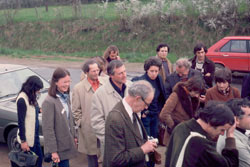
91 1980 Fautores at Banassac
For the names see here

92 1980 Le Journal d'Aveyron, 28.+29.4.1980. For better quality see here
|
“Les céramiques sigillées du sud de la Gaule” obviously was the theme of the Millau congress, again in France, hosted by Alain Vernhet [89]. And the amount of South Gaulish sigillata we were shown was overwhelming - as well as the sites of la Graufesenque itself, le Rozier and Banassac [90-91] and the impressive gorge of the Tarn we passed.
28 lectures were presented on one full and three half days, which were filled up by the visit of the site of La Graufesenque, the Musée Municipal and a Table ronde.
The opening speech by Elisabeth Ettlinger in four languages described very well the international community of the Fautores, who came to Millau in 102 and from 15 countries. Unfortunately the 14 registered Italians could not arrive. Quite a lot of local newspapers reported on the congress [92-94].
A number of Fautores, returning from this congress on the night-train to Paris, were considerably delayed when their train caught fire in the countryside. While standing beside the track, watching it burn, they were serenaded by a nightingale!
At the General Meeting the presidency went over from Elisabeth Ettlinger to Hans-Jörg Kellner.
|

93 1980 Midi libre, 29.4.1980.For better quality see here

94 1980 Journal de Millau, 2.5.1980.
For better quality see here |
__________________________________________________________________________________________
13th congress: Munich (D), 13.-15. 9. 1982
__________________________________________________________________________________________
14th congress: Oxford - London (GB), 5.-10. 9. 1984
__________________________________________________________________________________________
15th congress: Worms (D), 6.-11. 9. 1986

101 1986 Programme

103 1986 Iva Curk, ?, Ljudmila Plesničar at Rheinzabern

104 1986 Verena Gassner, Philip Kenrick at Rheinzabern

105 1986 Fridolin Reutti at Rheinzabern |

102 1986 Wormser Zeitung, 10.9.1986. For better quality see here |

106 1986 Jan Gunneweg, Marcel Lutz, Mrs Gunneweg at Rheinzabern

107 1986 Bettina Hoffmann, Charlotte Fischer at Rheinzabern

108 1986 Giuseppe Pucci at Rheinzabern

109 1986 Paul Wagner, Gergana Kabakchieva, Howard Comfort at Rheinzabern |
In 1986 Mathilde Grünewald hosted us at the museum at Worms with its famous face jugs [101-102].
Four days were filled with 32 lectures, mostly on sigillata, but also other wares and some reports on archaeometric analyses, and two half-day excursions to Rheinzabern and Speyer – and Mainz, respectively [103-111].
One evening we had a lovely concert, another one was devoted to a table ronde about Italian sigillata, which in consequence resulted in the Conspectus (see below).
|

110 1986 Colin Wells in the bus |

111 1986 Hans-Jörg Kellner, Hans Klumbach at Rheinzabern
|
__________________________________________________________________________________________
16th congress: Pleven (BG), 12.-18. 9. 1988

113 1988 Fautores at Oescus |

112 1988 Heading of the congress |

114 1988 Fautores at Butovo |
Five days we spent in Bulgaria to focus on production and distribution of pottery in the Danube provinces. Alexandra Milčeva, helped by Gergana Kabakchieva, organized this congress at Pleven [112]. |
36 lectures during four days, but including half-day excursions to Oescus [113] and the Museum of Pleven, were followed by a full day excusion to the production centres of Pavlikeni and Butovo with their lovely production sites and a “pottery-garden” to walk in and look at the sherds [114]. At every place the 48 participants were awaited by young people in their national costumes singing and dancing. And despite the poorness of the country the hospitality was enormous and we were served more meat than we could eat. |
___________________________________________________________________________________________
17th congress: Pavia (I), 10.-14. 9. 1990

115 1990 Maria Paola
Lavizzari Pedrazzini |
At Pavia sadly Howard Comfort and Elisabeth Ettlinger joined us for the last time – he died in 1993 at the age of 89, she in 2012 at the age of 96. Therefore here it was the last possibility to take pictures of both the “parents” of the Fautores, father Howard and mother Elisabeth [see 11-12].
This congress - held in memoriam of Arturo Stenico, who died ten years earlier, and organized by Maria Paola Lavizzari Pedrazzini [115-116] - comprised 4 days with 38 lectures focused on sigillata, and luckily in the middle a recreative excursion to museums at Milano, Casteggio e Gambolò [117-121]. |

116 1990 Programme
|

117 1990 Susanne Zabehlicky-Scheffenegger, Ljudmila Plesničar-Gec, Howard Comfort, Francesca Paola Porten Palange |

118 1990 Pierre Engel, Elisabeth Ettlinger, Bernard Hofmann |

119 1990 Teodora Tomasevic, Colette Bémont |

120 1990 Bernard Hofmann, Eleni Schindler Kaudelka |
At the General Meeting Hans-Jörg Kellner stepped down as president and Teodora Tomasevic-Buck was elected as his successor, while Gabriele Seitz became the new secretary. The Council included as well the former presidents Howard Comfort, Elisabeth Ettlinger and Hans-Jörg Kellner. It was agreed upon that this Council should serve only for a short term of two years and that at the next congress there should be new elections.
Since the Statutes were no longer up-to-date, a committee including the Council and Philip Kenrick, Paul Wagner and myself was established to prepare a new version for the next General Meeting. And by initiative of Bettina Hedinger another committee of nearly 20 persons was established to collect the new publications of their respective countries for the bibliography.
|

122 Conspectus formarum
Italicae modo confectae 1990
 123 Initiator and authors of the Conspectus: Giuseppe Pucci, Philip Kenrick, Howard Comfort, Susanne Zabehlicky-Scheffenegger, Elisabeth Ettlinger, Siegmar v. Schnurbein, Colin Wells, Katrin Roth-Rubi 123 Initiator and authors of the Conspectus: Giuseppe Pucci, Philip Kenrick, Howard Comfort, Susanne Zabehlicky-Scheffenegger, Elisabeth Ettlinger, Siegmar v. Schnurbein, Colin Wells, Katrin Roth-Rubi |
The main event of that congress was the presentation of the Conspectus [122]! The idea for this manual on Italian sigillata again originated from Howard Comfort, who at the Worms congress in 1986 gathered some people active in sigillata research and proposed to compile an overall overview of the forms, productions and so on. This resulted in a working group consisting of Elisabeth Ettlinger, Philip Kenrick, Giuseppe Pucci, Katrin Roth-Rubi, Siegmar v. Schnurbein, Colin Wells and myself.
We met several times for discussions, three times at Frankfurt, once each at Augst [123] and at Siena, while all the main work was done individually and by correspondence – that time via snail mail of course. It was not even possible to circulate drawings by fax, because most institutions still did not possess the new technology, and individuals certainly did not! Nevertheless it took only four years from the mere idea to the published book!
It is a child born, brought up and released by the community of the Fautores and couldn’t have come into existence without the fact, that people meet and get to know each other at these congresses.
And it was somehow followed by the OCK, the second edition of Oxe’s and Comfort’s Corpus vasorum Arretinorum, a catalogue of the signatures, shapes and chronology of Italian sigillata, issued in 2000 [124]. The idea to entrust Philip Kenrick with that immense work was also officially proposed at the Pavia congress. |

121 1990 Grace Simpson, Philip Kenrick, Vivien Swan

124 A. Oxé/H. Comfort/P.M.
Kenrick, Corpus vasorum
Arretinorum, second edition
(Bonn 2000) |
__________________________________________________________________________________________
18th congress: Székesféhervár (H), 13.-19. 9. 1992

125 1992 Guidebook
to the exhibition |
But back to the congresses: in 1992 for the second time we met in Hungary.
If my recollection is right, it was the first time that a main topic was proposed for a congress: it was the glazed pottery.
Many of the 42 lectures on four days therefore dealt with finds of glazed wares and a special exposition of the Hungarian material was set up for us [125].
It was great to learn about the many aspects of this pottery category in such a short time. |

126 1992 John Hayes, Kathleen Slane at Gorsium

127 1992 Fautores at the villa of Baláca
|
Excursions led us to Gorsium [126],
Baláca [127]
and finally
to Budapest [128-129]
with visits
of the civil town and legionary fortress
and an exhibition of the pottery workshops of Aquincum.
|

128 1992 Fautores in Budapest. For the names see here

129 1992 Fautores in Budapest. For the names see here
|
It was at the General Meeting that a nearly complete new Council took over: Jan Kees Haalebos as President, Katrin Roth-Rubi as Secretary, Susanne Zabehlicky-Scheffenegger as Editor, while only Simon Wynia stayed as Treasurer for another term of two years. We then added to the council a fifth member without any other duty than to contribute to a majority in decisions: Dénes Gabler was elected. The photos [130-131] were taken three years later in Switzerland, therefore also Philip Kenrick as the later Treasurer is present. We took over the society in a crucial financial situation, but could improve that very soon.
And also new elaborated Statutes were approved, which – with some minor amendments – are valid till today [132]. |
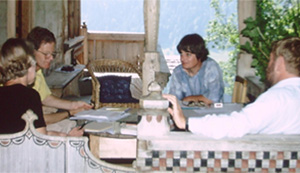
130 1995 Council: Katrin Roth-Rubi, Philip Kenrick, Susanne Zabehlicky-Scheffenegger, Jan Kees Haalebos
|

132 Statutes 1992/1994
For the details see here
|
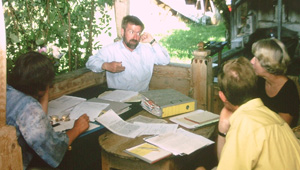
131 1995 Council: Susanne Zabehlicky-Scheffenegger, Jan Kees Haalebos, Philip Kenrick, Katrin Roth-Rubi
|
__________________________________________________________________________________________
19th congress: Timişoara (R), 28. 8. - 4. 9. 1994
 133 1994 Programme
133 1994 Programme
|
For the next congress we stayed in the Balkans and went a bit further south to Timişoara, Romania [133]. The lectures focused, as proposed by the organizers, on centres of pottery production in the provinces, mortaria, lamps and interdisciplinary research.
About 30 papers were presented and we had a 2 days excursion visiting Tibiscum, Sarmizegetusa, where we were welcomed by the excavator Ioan Piso [134-135], and the annual potters’ market at Sibiu [136]. There you could see nearly every Fautor carrying a parcel with traditional Romanian pottery – and many keep them up to now.
87 participants are listed in the programme. But only about 40 came, due to late announcements.
|

134 1994 Ioan Piso, Jan Kees Haalebos, Philip Kenrick, ?, Dénes Gabler at Sarmizegetusa
|
To imagine the unexpected as well as expected difficulties the organizers had to master, there was a fire in the university a month before the congress and a heavy storm a few days before the congress cut down a lot of trees within the town, over which we had to step on our way from the hotel to the conference hall. We could receive a booklet of abstracts, but for its production the paper had to be scrounged and imported from Switzerland!
But the hospitality was great and how this international congress was esteemed one can value from our President Haalebos starring on the front page of the newspaper, as well as Gheorge Popilian [137-138].
Within the General Meeting the treasurership went from Simon Wynia over to Philip Kenrick. |
 137 1994 Renaşterea
137 1994 Renaşterea
bănăteană,1.9.1994,
with Jan Kees Haalebos.
For details see here
|

135 1994 Fautores at Sarmizegetusa |

136 1994 Potters' market at Sibiu |

138 1994 Renaşterea bănătană, 3.9.1994, with Gheorge Popilian.
For details see here |
____________________________________________________________________________________________
20th congress: York - Newcastle (GB), 9.-16. 9. 1996

145 1996 Philip Kenrick, Anna Marguerite McCann, Katrin Roth-Rubi |
|
At the General Assembly a decision was made to set up a separate fund in order to help a few of those in need, or from countries with weak currencies, to attend our congresses. From this came about the RCRF Trust, a charitable foundation established in the UK, into which ten per cent of all membership subscriptions is transferred. The Trust has also benefited from individual donations (notably by an American member and long-standing friend of Howard Comfort, Anna Marguerite McCann [145]) and has provided a mechanism for carrying forward any surplus remaining from one congress to the next. The Trust made its first grants in 1998, and since then has made a total of 132 grants.
The RCRF Communicationes of 1997 contained not only the usual reports concerning our society, but also a retrospection of its first fourty years, as well by a humorous limerick by Philip Kenrick [146] as by retrospective articles by Elisabeth Ettlinger and myself (p. 58-78).
|
|

146 Communicationes 39, 1997, front page. For details see here
|
|
__________________________________________________________________________________________
21st congress: Ephesus - Pergamum (TR), 27. 9 - 6. 10. 1998
 147 1998 Programme
147 1998 Programme
 148 1998 Guidebook to the exhibition
148 1998 Guidebook to the exhibition
 149 1998 Fautores at Metropolis 149 1998 Fautores at Metropolis 150 1998 Fautores at Pergamum 150 1998 Fautores at Pergamum
|
In 1998 I had the honour to organize the hitherto most easterly congress and the first outside Europe [147]. Its aim to connect East and West and to include the pottery studies of the eastern Mediterranean was fulfilled perfectly. The main theme of this congress was East and West, including: Hellenistic pottery; pottery production in the East; pottery at Ephesus; east-western pottery exchange; technological transfer and trading connections; amphorae in east and west; western pottery in east and west; archaeometry, production and technology. With 146 participants it was at that time the largest congress ever held and therefore resulted in the largest Acta volume as well. We needed a full week for the main programme. All the 45 lectures were held at Selçuk (the modern town of Ephesus) with the 64 posters encircling the auditorium.
Of course also the surroundings induced many scholars to attend the congress. We visited the site of Ephesus and a special pottery exhibition in the Austrian excavation camp, for which we had prepared a comprehensive booklet [148].
A half day excursion went to Metropolis [149], where Recep Meriç explained to us his newest results. We had a full day trip to Pergamon [150-151], where we were welcomed by the German Archaeological Institute and guided by the excavator Wolfgang Radt [152], with whom the conference was co-organized.
Some tables with pottery were put up there as well [153-154]. |
 151 1998 Fautores at Pergamum 151 1998 Fautores at Pergamum

152 1998 Wolfgang Radt 
153 1998 Pottery display at Pergamum
 154 1998 Pottery display at Pergamum 154 1998 Pottery display at Pergamum
|

155 1998 Potter's workshop

156 1998 ?, Dénes Gabler, John Hayes at the potter's workshop
|
At the end we travelled to the Maeander valley to visit a local potter still working as in ancient times and heating his kiln with shrub only. It was a great delight for all Fautores to look into the workshop and creep into the kiln [155-158].
At the General Assembly the whole Council was re-elected for a second term of office. The Treasurer reported that the RCRF prior to the congress has a total membership of 326, consisting of 6 Honorary, 96 Affiliated and 224 Ordinary Members.
Two full-day post-congress tours took us to Priene, Miletus, Didyma amd Heracleia on the first one and to Aphrodisias and Hierapolis-Pammukkale on the second one. |

157 1998 Fautores at the potter's workshop

158 1998 Kiln at the potter's workshop
|
__________________________________________________________________________________
22nd congress: Lyon (F), 1.-8. 10. 2000

159 2000 Programme

160 2000 ?, Colin Wells, ?, Allard Mees, Armand Desbas, Archer Martin, Simonetta Menchelli, Hannah Liko
|
At the invitation of Armand Desbat the Fautores went to Lyon in 2000 [159-160]. Accordingly, the focus was on the pottery production in the Rhône valley.
We were accommodated all together in the Centre d’accueil de Valpré outside Lyon, locked up at 10 pm, but it was pleasant to be together all the time, so discussions could continue all the nights long.
We had our lectures there, but also at the Musée de la civilisation gallo-romaine at Lyon and at Saint-Romain-en-Gal. In both places there was enough leisure time to see the city and the site.
There were already three poster sessions supplementing the 44 papers. A mid-term excursion directed us to Bibracte with visits to the site and museum and the General Assembly, where Philip Kenrick was re-elected as Treasurer. With a last-day excursion we could taste Roman wine and visit Glanum and Saint-Rémy.
|
_________________________________________________________________________________
23rd congress: Rome (I), 29. 9. - 6. 10. 2002
 161 2002 Programme
161 2002 Programme |
Finally in 2002 we gathered at the very centre of the Roman world, in Rome itself [161]. Archer Martin, with the assistance of Eric De Sena, organized the meeting at the American Academy in the Villa Aurelia on the Gianicolo [162].
A quote from a report by Archer Martin: “The Academy venue was appropriate as Howard Comfort was fellow in Classical Studies and Archaeology here in 1929. Several of the older members remarked ‘How pleased Howard would have been!’
|

162 2002 Fautores at the Villa Aurelia
 163 2002 Fautores at the Monte Testaccio. For the names see here
163 2002 Fautores at the Monte Testaccio. For the names see here
|
Some 150 scholars from four continents attended – Australia was present too.Pottery production in Italy, especially of Rome and Ostia, was in the foreground of the presentations, accompanied by special exhibitions.
The programme also included visits to Monte Testaccio, where José Remesal Rodríguez showed us around [163-165], the recently opened Crypta Balbi Museum, to Ostia and in the end to Cosa in order to give the participants a taste of the riches of the Roman ceramic tradition in central Italy from the republican period to the end of antiquity.
Most remarkable was the final dinner near Cosa, generously offered by Anna Marguerite McCann and her husband, after which nobody wanted to board the busses, because everyone still wanted to say something to someone or to hug someone else good-bye.” |
|

164 2002 Fautores at the Monte Testaccio. For the names see here
165 2002 Fautores at the Monte Testaccio
|
|
| However, this lovely meeting was overshadowed by the sudden death of our President Jan Kees Haalebos in March 2001. So at the General Meeting Colin Wells was elected as the new President. Since also Dénes Gabler retired as Ordinary Member of the Council, Armand Desbat followed him. |
__________________________________________________________________________________________
24th congress: Namur -Leuven - Louvain-la-Neuve (B), 26. 9. - 2. 10. 2004
__________________________________________________________________________________________
25th congress: Durrёs (AL), 24. 9. - 1. 10. 2006

174 2006 Poster session

175 2006 Pottery display at Lezha
|
We were offered much space for the posters [174] and pottery display. Although renovations of the conference hall were not yet finished, we enjoyed the atmosphere very much: problems were solved improvising with charm and sense of humour.
Excursions to Lissus/Lezha [175], Shkodra, Apollonia [176] and Tirana as well as a post-congress tour to Butrint [177] also gave us an impression of the beautiful landscape and the rich historic heritage of Albania.
After twelve years of dedicated work on our behalf our Treasurer, Philip Kenrick, had to retire from office and was succeeded by Archer Martin. Since Sabine Ladstätter resigned after only two years, Susanne Biegert became our new Editor. Both are serving until now [178].
|

177 2006 Fautores at Butrint |

178 2006 Archer Martin, Susanne
Biegert
at the General Assembly |
__________________________________________________________________________________________
26th congress: Cádiz (E), 28. 9. - 4. 10. 2008

179 2008 Dario Bernal |
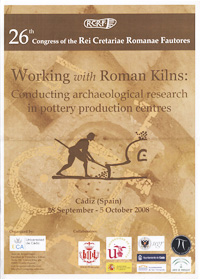
181 2008 Poster |
 180
180 2008 Macarena Bustamante,
Albert Ribera |
For the first time after the congress in Mallorca 1965, our meeting took place in Hispania in 2008 at Cádiz, organized by Darío Bernal Casasola and Albert Ribera i Lacomba [179-180] together with several other colleagues from the region. They presented us with a great variety of lectures and excursions under the main subject „Trabajando sobre Hornos Romanos/Working with Roman Kilns“ [181-182].
We could visit the Museum of Cádiz and appreciate the wonderful excursions which guided us to Baelo Claudia [183], Itálica and Sevilla, ending with a fulminant spectacle at Jerez de la Frontera. We had two pottery displays and a two-day post-congress tour was offered to Córdoba and Madinat Al Zahra. We were delighted with delicious meals, starting with the “finger food” during the breaks in the University’s courtyard [184], and ending with menus of several courses of regional specialities – and we never missed the famous typical Manzanilla. |

182 2008 Poster session
|

183 2008 Fautores at Baelo Claudia |

184 2008 Fridolin Reutti, Thierry Martin, Christa Schauer during a coffee break |
In accordance with the theme of the conference we learned much about the manifold pottery production in the region. And every participant received the weighty book “Cerámicas hispanorromanas. Un estado de la cuestión“, edited by the two organizers of the conference [185].
On this occasion, our President Colin Wells did not seek re-election, and he was succeeded instead by Philip Kenrick [186]. Sadly it proved to be the last time that both he and Vivien Swan, very brave in her wheelchair [187], were with us. Tatjana Cvjetićanin succeeded Armand Desbat as Ordinary Member. |

185 2008 D. Bernal/A. Ribera (eds.), Cerámicas hispanorromanas. Un estade de la cuestión (Cádiz 2008)
|

186 2008 Philip Kenrick, Colin Wells
at the General Assembly |

187 2008 Kate Wells, Vivien Swan
|
__________________________________________________________________________________________
27th congress: Belgrade (RS), 19.-24. 9. 2010
 188 2010 Tatjana Cvjetićanin, Vesna Bikic, Vera Krstic 188 2010 Tatjana Cvjetićanin, Vesna Bikic, Vera Krstic
|

189 2010 Programme
|

190 2010 Exhibition "Roman pottery in Moesia superior" |
The 2010 congress took place in Serbia and was organized by Tatjana Cvjetićanin with her helpers Vesna Bikić and Vera Krstić [188]. It focused on “Late Roman and Early Byzantine pottery: the end or continuity of Roman production?” [189] We heard 41 papers and looked at 50 posters. We gathered in the National Museum, temporarily closed to the public for refurbishment, where we had a lot of space for the poster displays and could admire a jewellery-like presented exhibition of “Roman pottery in Moesia Superior” [190]. |
 191 2010 Pottery display at Belgrade. Heinrich Zabehlicky, Friderika Horváth, Eduard Krekovič, Verena Vidrih-Perko, Susanne Biegert 191 2010 Pottery display at Belgrade. Heinrich Zabehlicky, Friderika Horváth, Eduard Krekovič, Verena Vidrih-Perko, Susanne Biegert
|
At all places of our excursions we were able to see and touch a lot of pottery: at the fortress of Belgrade [191], at Požarevac [192], Viminacium [193] and Sirmium [194].
The post-congress tour took us to Gamzigrad-Felix Romuliana [195] and the Iron Gate. Unexpected was the fact, that on a public promenade leading to the fortress Kalemegdan there was a photographic exhibition on the theme “Ceramic pots through the centuries in Belgrade” [196]. And our orange bags were shining everywhere! On the last day we gathered for the usual group photo [197]. (See also the photo gallery at our website.)
At the General Meeting Pia Eschbaumer was re-elected as Secretary. Our recently installed website was presented and is maintained since then by our webmaster Fridolin Reutti. |

193 2010 Pottery display at Viminacium. ?, Archer Martin, Pia Eschbaumer, ?, Tino Leleković, ?, ?, ?, Susanne Biegert, Eckhard Laufer |

192 2010 Pottery display at Požarevac. Herbert Riedl, Meike Weber, Dénes Gabler, Friderika Horváth, Felix Teichner, Marek Palaczyk |

194 2010 Pottery display at Sirmium. For better size and the names see here
|

195 2010 Lunch at Gamzigrad. Paola Ventura, Catarina Viegas, Yona Waksman, Malcolm Lyne, ?, Vesna Bikić, ?, Eckhard Laufer |

196 2010 Street exhibition at Belgrade. Philip Kenrick, Susanne Biegert, Dénes Gabler |
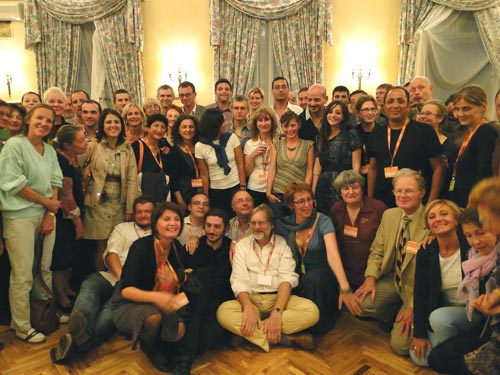
197 2010 Fautores in Belgrade. For better size and the names see here |
__________________________________________________________________________________________
28th congress: Catania (I), 23.-30. 9. 2012

198 2012 John Lund, Jeroen
Poblome,
Daniele Malfitana
|

199 2012 Elephants
In 2012 we were invited by Daniele Malfitana [198] to Sicily, welcomed by the elephant on the Piazza del Duomo at Catania and on our signet [199] as well as on the fabric wallcovering of the lecture hall [200].
„From broken pottery to lost identity in Roman times“ was the advertising motto [201] and ca. 50 papers and ca. 80 posters enriched our knowledge.
We had a guided tour to the Roman theatre in Catania [202] with a pottery display in its museum. Excursions led us to Centuripe (visit of the Archaeological Museum, pottery display and a practical demonstrating of potting [203]) as well as to Syracuse, where we had some lectures (among these also my presentation of this history of the RCRF) [204-205] and another pottery display at the Archaeological Museum “Paolo Orsi” and visited the amphitheatre, theatre and quarries [206].
During the two-day post-congress tour visits of Agrigento, Selinunte, Segesta and Palermo were provided.
(See also the photo gallery at http://rcrfcatania2012.ibam.cnr.it/.)
At the General Meeting two main items were settled: the re-election of Archer Martin and Susanne Biegert as Treasurer and Editor, respectively, and the dissolution of the UK-based RCRF Trust. Its main function - to assess grant applications for future congresses - will now be fulfilled by a new "Grants Committee", while the relevant funds are held within the general funds of the RCRF by the Treasurer. |

200 2012 Audience at Catania |

201 2012 Programme

202 2012 Fautores in the Roman theatre in Catania |

203 2012 Potter working at Centuripe

204 2012 Audience at Syracuse
|
 205
205 2012 Susanne Zabehlicky-Scheffenegger during her lecture
|
|
 206
206 2012 Fautores in the Roman theatre at Syracuse
|
|
__________________________________________________________________________________________
29th congress: Xanten (D), 21.-27. 9. 2014

207 2010 Bernd Liesen proposing
the congress 2014 at Xanten |
|
Invited by Bernd Liesen [207] we shall gather soon at Xanten
and are very much looking forward to another exciting event! |
__________________________________________________________________________________________
And the 30th congress: Lisbon (P), 2016 is already proposed by Catarina Viegas.
THE STORY GOES ON!
__________________________________________________________________________________________
__________________________________________________________________________________________
Picture credits:
10, 90, 97: Philip Kenrick
14: Hedwig Kenner
62: presumably Grace Simpson
73, 76: Ruth Steiger
74, 78-85: C.A. Kalee
87-88, 99, 103-111, 113-114, 115, 118-121, 126-129, 134-136, 140, 142-145, 149-158, 160, 162-166, 168-169, 171, 174-176, 178-180,
182-184, 186-188, 191-196, 198, 200, 202-203, 207: Susanne Zabehlicky-Scheffenegger
117, 130-131, 197: Heinrich Zabehlicky
170: G. Schalenbourg
173, 177: Tristan Sherif
190: Susanne Biegert
204-206: http://rcrfcatania2012.ibam.cnr.it/
For all other pictures of persons, throughout private ones, the source is unknown.
 1 Howard Comfort (1904-1993)
1 Howard Comfort (1904-1993) 2 H. Comfort, De collectione praecipue epigraphica vasculorum Arretinorum apud Academiam Americanam conservata. Memoirs of the American Academy in Rome 7, 1929, 177-219
2 H. Comfort, De collectione praecipue epigraphica vasculorum Arretinorum apud Academiam Americanam conservata. Memoirs of the American Academy in Rome 7, 1929, 177-219 3 A. Oxé/H. Comfort, Corpus Vasorum Arretinorum (Bonn 1968)
3 A. Oxé/H. Comfort, Corpus Vasorum Arretinorum (Bonn 1968)










































 47
47 48
48 49
49 52
52 50
50




















































































































